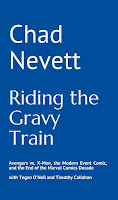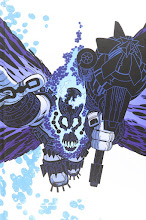“How the Groonk Stole Christmas!” lives for the holiday cliché. Tom DeFalco and Ron Frenz, well into their creative partnership, manage to take a fairly regular issue of their Thor run and deck it out with as many Christmas clichés and references as they can manage. From the titular Groonk being a friendly allusion to the Grinch, from his green appearance and Santa suit to his dog Max with one antler to a little girl named Cindy Lou that sticks up for him. Beyond that, there’s every holiday movie about a parent feeling estranged from their kid, or down on his luck due to money issues, or feeling like a worthless human. DeFalco and Frenz rip off the classics from A Christmas Carol to It’s a Wonderful Life. And, surprisingly, it works.
What could be eye-rolling never quite crosses the line because, firstly, DeFalco and Frenz are pretty clear that they know how cheesy and sappy this comic is. Every reference comes with a little wink that lets you know that they’re in on it too. Mostly, it’s that those elements are flourishes added here and there to what could be a non-Christmas issue of Thor. The entire issue is rooted in the ongoing struggles of Eric Masterson with the holidays acting as a focal point to magnify some of them. That root in Eric and his problems carries the issue past the Christmas clichés and actually lets a few of them land. By focusing on the genuine goodness of that character as he struggles to get through the day, DeFalco and Frenz transform Christmas clichés into a moving finale that feels earned – and welcomed.
The issue opens on Eric having spent nearly five hundred dollars on a gift for his son. Broke, about to lose his apartment due to superhero-related destruction, his architect career barely hanging on, and the general feeling that he’s a failure as Thor, the first page and a half is one long self-pitying monologue over a dozen or so thought bubbles. When a fellow shopper is robbed of only one of her many presents, the superhero plot of the issue is introduced. Apparently, there is a mugger who has been stealing a single present from people, seemingly at random (the people and the present). It seems like a simple criminal to take down and one that Eric feels good about trying to stop. There’s a sense that, if he’s able to catch this thief and return the stolen presents, he’ll have done something good at the holidays. He never says it outright, but the alluded outcome is that he’ll be saving Christmas, in a sense.
The visit with his son, Kevin, does little to lift his spirits. Despite giving him a much-desired gift that he can barely afford, Eric feels like a letdown to Kevin. His ex-wife is married to a professional football player and Eric feels like he can’t measure up to the lifestyle that they’re providing for Kevin. Even though his relationship with his ex and her husband is amicable, especially since he willing gave up custody of Kevin (to spare him the fallout of his double life as Thor), the strains of his superhero alter ego and the time away from his son turn it into a competition in his mind. He readily acknowledges that the expensive gift is an effort to ‘bride’ Kevin into overlooking his failings as a father and he’s so wrapped up in those feelings of inadequacy that he blows off Marcy’s invitation for him to join them for dinner and spend more time with Kevin.
His self-sabotage and desire to prove himself is a recurring feature in the issue, especially when he finally confronts the robber. It turns out to be a giant, hulking green monster in a Santa outfit that only yells the word “Groonk!” Their battle takes them into a shopping mall and Eric’s need to take down this seeming monster causes him to go all out and not do the best job at keeping the innocent people around them safe. At one point, he ducks an eye blast from the Groonk before realising that it was meant for a beam that, now broken, allows part of the ceiling to fall in. When the battle leads into the sewers, Eric almost fights against a group of homeless people living there until a little girl, Cindy Lou, intervenes and explains the situation. The Groonk is normally a gentle creature that, inspired by a story about Christmas, has been stealing presents to give everyone living in the sewer a proper Christmas. As I said, it’s a little cloying except for the way that it works against your typical superhero story.
Captain America would later chastise Eric for his handling of the situation: Eric takes back the stolen gifts, but doesn’t turn the Groonk into the police. He’s able to see that there’s no justice as it was a well-meaning gesture by someone who didn’t know any better. And that’s without getting into the question of whether or not it was wrong at all and what more could be done to help the group of people living in the sewers. Eric’s willingness to not do the typical superhero thing and treat the ‘bad guy’ with genuine respect and compassion is one of the things that sets him apart. Not many superheroes are willing to give a seeming villain a chance – and the comic’s continued use of Captain America’s ‘disappointed dad’ lectures is meant to drive that point home.
Like many Christmas stories, that decision to do something nice and good almost seems to provoke a chain of good fortune for Eric. Visiting his assistant and friend in the hospital, she finally wakes up from a coma that Loki put her in; running into Captain America on the street, the Avengers leader offers Eric a room at the mansion since he’s losing his apartment; and, returning home, he finds that his son and friends have organised a Christmas party for him. They all know that he’s going through a rough patch and want him to know that they’re there for him. This reveal is alluded to in a couple of earlier scenes where the beginnings of it come together via Kevin and one of Eric’s friends. That he has a group of people who care about him and love him is that reminder he needs that he’s a good guy and he’s not a failure. None of them (save Hercules in his ‘Harry Cleese’ persona) know that he’s Thor and the good that he does all of the time – but they know Eric and the good that he exudes in his daily life. The sort that we see when he’s Thor and, instead of continuing to punch the Groonk in the face, he hears out why this seeming monster is stealing Christmas presents and, then, acts with compassion rather than some rigid concept of justice that does no good for anyone.
Even with all of this, DeFalco’s dialogue can lean into the cheese a bit, whether it’s melodrama or hamming it up with the jokey quips, and Frenz’s art carries a big part of ensuring that the emotional beats of this issue land. He’s so good at pacing those scenes and giving the perfect panel when it’s needed. Like the genuine shock on Eric’s face when he returns home to find his son waiting and, then, to see the party that everyone has made for him. Or the chastised look of self-pity when Captain America lectures him. Or, my favourite, the three panels of Eric hugging his son goodbye where the moment lingers too long because neither one wants to let go. All of my favourite Ron Frenz Thor moments are between Eric and Kevin because Frenz depicts the genuine love between them in a way that transcends words. It’s so obvious and immediate when you see the art on the page. It always hits me hard.
And that’s what I mean when I said that this is a regular issue of the DeFalco/Frenz Thor run with Christmas elements added on top. While the two use those elements to play up the problems that Eric is going through, they rely on those pre-existing, ongoing problems. These aren’t new difficulties that arise when the issue begins and are solved when the issue ends. Taken by itself, I think that the final pages are earned by what happens throughout the issue leading up to them. I’m sure some will dismiss it as a bit too much of It’s a Wonderful Life with the whole group of people coming together to throw Eric a party – for ongoing readers who have seen the build up of Eric’s various problems, things like Susan waking up and Eric coming home to a party thrown by his son and friends is the exact thing that a Christmas issue needs. It needs a sappy feel good ending.
And so does Eric Masterson.







